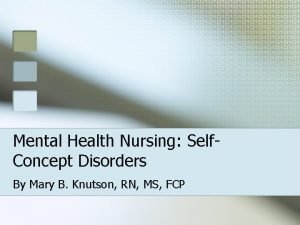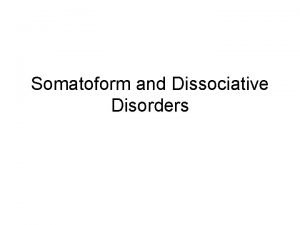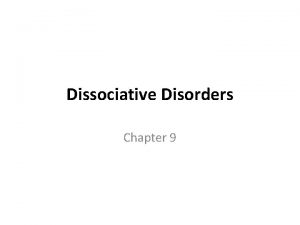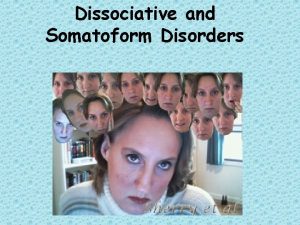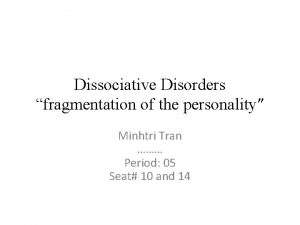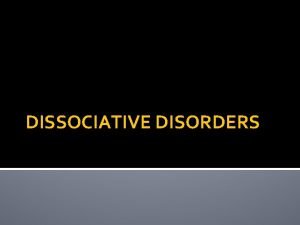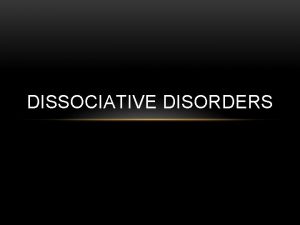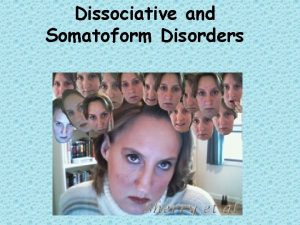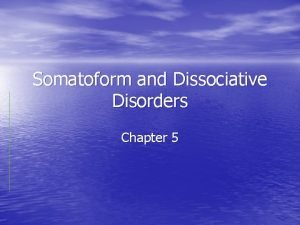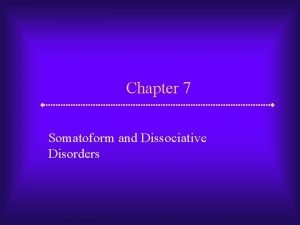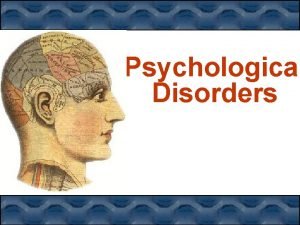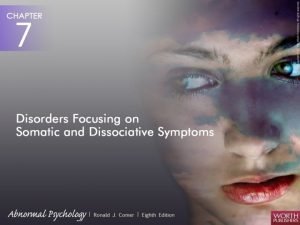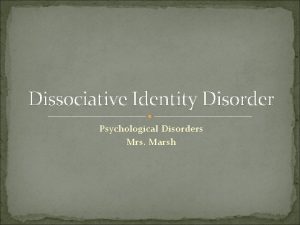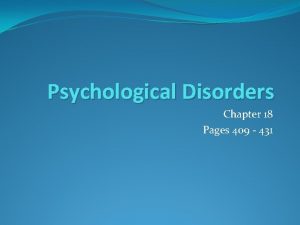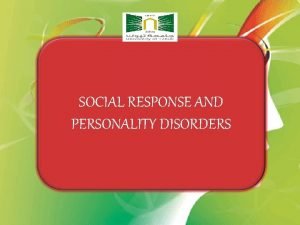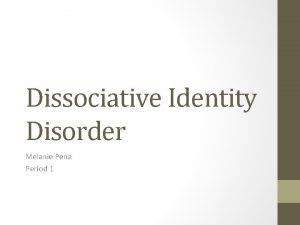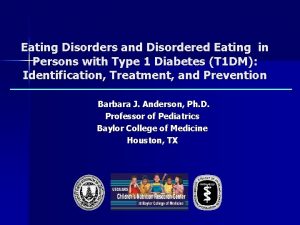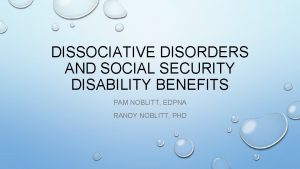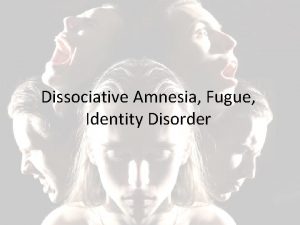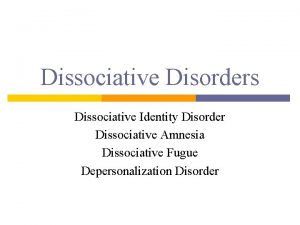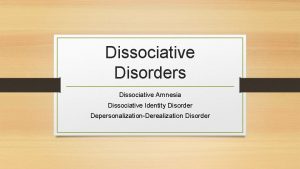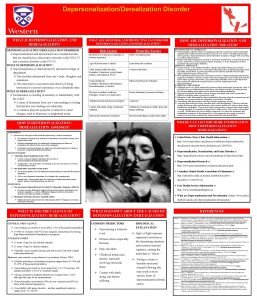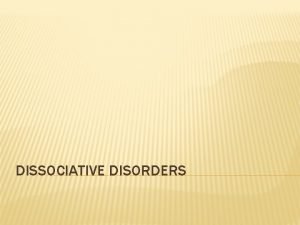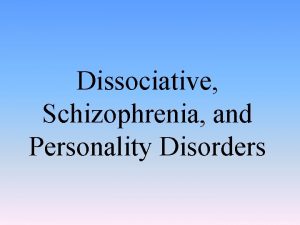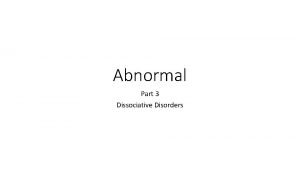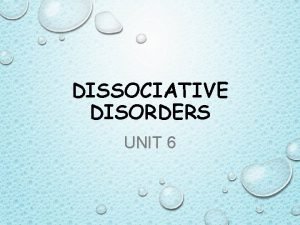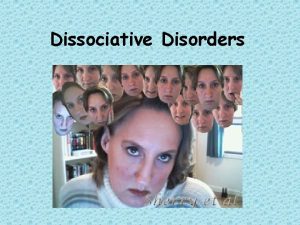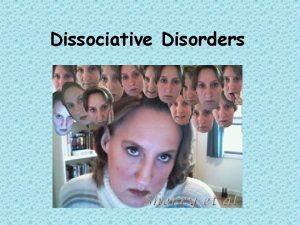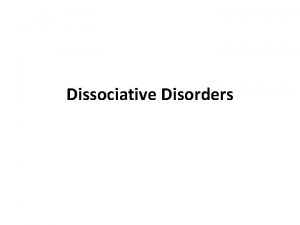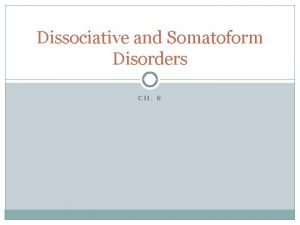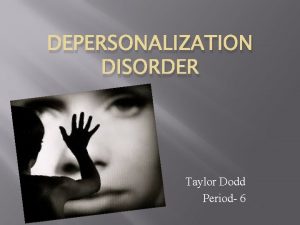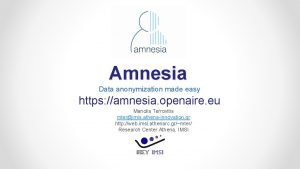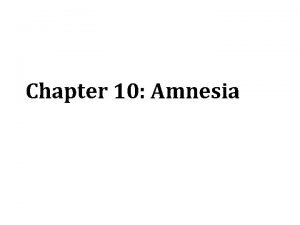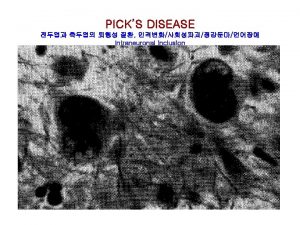Dissociative Disorders Dissociative Amnesia Dissociative Fugue Depersonalization disorder



























- Slides: 27


Dissociative Disorders • • Dissociative Amnesia Dissociative Fugue Depersonalization disorder Dissociative identity disorder • Dissociative Disorder Not Other Specified (NOS)

Childhood Abuse and comorbidity (A) • Chronic PTSD • Dissociative Disorder • Personality Disorders (B. P. D, Narcissistic, Histrionic, Antisocial, Avoidant, Compulsive, Passive-Aggressive) • Conversion Dis. (Roelof et. Al. Am j Psych. 2002). • Eating Dis. : Anorexia Nervosa (“Binging –purging type”) Bulimia Nervosa (+B. P. D) Morbid Obesity

Childhood Abuse and comorbidity(B) • Major Depressive Disorder. Erica. L, Mazure Am. J of Psych. 1999 (3 -5 times more common than in women without CSA). שכיחות דיכאון מג'ורי גבוהה יותר באלו שעברו חדירה וכן שכיחות ניסיונות . ההתאבדות , כשהקרבה המשפחתית גדלה , גרועה יותר כשהייתה חדירה : פרוגנוזה . כשהתעללות ממושכת יותר ואצל גברים • Substance Abuse. • Anxiety Dis. (Phobias OCD) • Somatization and Somatic illness (IBS, Vestibulitis) • Psychosis • Factitious Disorder with Psychological Symptoms

פסיכוזות • Brief Psychotic Disorder • Schizophreniform Disorder • Schizophrenia Catatonic | Disorganized | Paranoid | Residual |Undifferentiated • Schizoaffective Disorder • Delusional Disorder • Shared Psychotic Disorder • Psychotic Disorder Due to a General Medical Condition • Substance-Induced Psychotic Disorder • Psychotic Disorder NOS



Schneider`s First rank symptoms (1959) • • 1 - Audible thoughts. 2 - Voices arguing. 3 - Commentary voices. 4 - Delusional perception. 5 - Somatic passivity. 6 - “Made” thoughts. 7 - “Made” impulses. 8 - Made volitional acts. • 9 - Thought withdrawal. • 10 - Thought insertion. • 11 - Thought broadcasting.



Schizophrenia DSM IV TR • a person must display : Two or more of the following, each present for much of the time during a one-month period (or less, if symptoms remitted with treatment) – delusions – hallucinations – disorganized speech (e. g. , frequent derailment or incoherence; speaking in abstracts). See thought disorder. – grossly disorganized behavior (e. g. dressing inappropriately, crying frequently) or catatonic behavior – negative symptoms, i. e. , affective flattening (lack or decline in emotional response), alogia (lack or decline in speech), or avolition (lack or decline in motivation). • Note: If delusions are judged to be bizarre, or hallucinations consist of hearing one voice participating in a running commentary of the patient's actions or of hearing two or more voices conversing with each other, only that symptom is required above. The speech disorganization criterion is only met if it is severe enough to substantially impair communication.

Schizophrenia DSM IV TR • Social/occupational dysfunction: For a significant portion of the time since the onset of the disturbance, one or more major areas of functioning such as work, interpersonal relations, or self-care, are markedly below the level achieved prior to the onset. • Duration: Continuous signs of the disturbance persist for at least six months. This six-month period must include at least one month of symptoms (or less, if symptoms remitted with treatment). • Schizophrenia cannot be diagnosed if symptoms of mood disorder or pervasive developmental disorder are present, or the symptoms are the direct result of a general medical condition or a substance, such as abuse of a drug or medication.

Diagnostic criteria for Schizophrenia Catatonic Type • A type of Schizophrenia in which the clinical picture is dominated by at least two of the following: • (1) motoric immobility as evidenced by catalepsy (including waxy flexibility) or stupor (2) excessive motor activity (that is apparently purposeless and not influenced by external stimuli) (3) extreme negativism (an apparently motiveless resistance to all instructions or maintenance of a rigid posture against attempts to be moved) or mutism (4) peculiarities of voluntary movement as evidenced by posturing (voluntary assumption of inappropriate or bizarre postures), stereotyped movements, prominent mannerisms, or prominent grimacing (5) echolalia or echopraxia

Schizophrenia Disorganized Type A type of Schizophrenia in which the following criteria are met : A. All of the following are prominent : 1) disorganized speech 2) disorganized behavior 3) flat or inappropriate affect B. The criteria are not met for Catatonic. Type. Also: , hebephrenia


Schizophrenia Paranoid Type A type of Schizophrenia in which the following criteria are met: • A. Preoccupation with one or more delusions or frequent auditory hallucinations. • B. None of the following is prominent: disorganized speech, disorganized or catatonic behavior, or flat or inappropriate affect.

Diagnostic criteria for Brief Psychotic Disorder A. Presence of one (or more) of the following symptoms : • A. (1) delusions (2) hallucinations (3) disorganized speech (e. g. , frequent derailment or incoherence) (4) grossly disorganized or catatonic behavior • Note: Do not include a symptom if it is a culturally sanctioned response pattern. • B. Duration of an episode of the disturbance is at least 1 day but less than 1 month, with eventual full return to premorbid level of functioning. • C. The disturbance is not better accounted for by a Mood Disorder With Psychotic Features , Schizoaffective Disorder , or Schizophrenia and is not due to the direct physiological effects of a

Schizophrenia



Feeling Unreal: A PET Study of Depersonalization Disorder • Conclusion: • Depersonalization appears to be associated with functional abnormalities along sequential hierarchical areas, secondary and cross-modal, of the sensory cortex (visual, auditory, and somatosensory), as well as areas responsible for an integrated body schema. These findings are in good agreement with the phenomenological conceptualization of depersonalization as a dissociation of perceptions as well as with the subjective symptoms of depersonalization disorder. • Am J Psychiatry 157: 1782 -1788, November 2000

Hippocampal and Amygdalar Volumes in Dissociative Identity Disorder RESULTS: Hippocampal volume was 19. 2% smaller and amygdalar volume was 31. 6% smaller in the patients with dissociative identity disorder, compared to the healthy subjects. The ratio of hippocampal volume to amygdalar volume was significantly different between groups. CONCLUSIONS: The findings are consistent with the presence of smaller hippocampal and amygdalar volumes in patients with dissociative identity disorder, compared with healthy subjects. Am J Psychiatry 163: 630 -636, April 2006



ביולוגים בעקבות הסטרס - שינויים נוירו CSA - הממושך ב Glucocorticoid cascade hypothesis ומעלה רמות של HPA axis סטרס ממושך מפעיל . אלו גורמים לנזק בהיפוקמפוס. גלוקוקורטיקואידים Insufficient glucocorticoid signaling Insulin resistance : תורם לתחלואה הקשורה לסטרס , Sickness behavior , Osteoporosis , Diabetes. T cells- דיכוי ה , ch. Pain Raison &Miller Am J Psych. Sep. 2003


 Depersonalization disorder
Depersonalization disorder Depersonalization disorder
Depersonalization disorder Nursing diagnosis of dissociative disorder
Nursing diagnosis of dissociative disorder Dissociative fugue
Dissociative fugue Depersonalization
Depersonalization Clipart dissociative fugue
Clipart dissociative fugue Dissociative disorder
Dissociative disorder Dissociative fugue
Dissociative fugue Disassociative amnesia
Disassociative amnesia Dissociative conversion disorder
Dissociative conversion disorder Dissociative amnesia
Dissociative amnesia Somatic symptom disorder
Somatic symptom disorder Types of dissociative disorders
Types of dissociative disorders Dissociative disorders
Dissociative disorders Dissociative disorder
Dissociative disorder Culture bound syndrome examples
Culture bound syndrome examples Dissociative disorder not otherwise specified
Dissociative disorder not otherwise specified Dissociative conversion disorder
Dissociative conversion disorder Jeanne fery
Jeanne fery Dissociative identidy disorder
Dissociative identidy disorder Did
Did Dissociative disorder not otherwise specified
Dissociative disorder not otherwise specified Dissociative disorder not otherwise specified
Dissociative disorder not otherwise specified Dissociative identity disorder social security disability
Dissociative identity disorder social security disability Malingering
Malingering Permutationsfuge
Permutationsfuge Trans disosiatif
Trans disosiatif Hebephrenic fugue
Hebephrenic fugue
